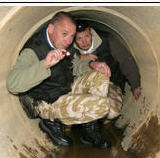Chapter 4: The real victim is the missing child
The Complete Mystery of Madeleine McCann™ :: Books on the Madeleine McCann case :: Gonçalo Amaral's book: 'Maddie: The truth of the lie'
Page 1 of 1 • Share
 Chapter 4: The real victim is the missing child
Chapter 4: The real victim is the missing child

THE REAL VICTIM IS THE MISSING CHILD
In a criminal investigation, knowledge of the victim is essential. A physical description is not enough. Her personality, her habits, other interests, her family background and her friendships allow a better understanding of the conditions in which the crime was committed. Knowing about her actions and her movements before her disappearance or her death also helps to determine the motive for the crime. The work is made easier when it's about an adult person with real life experience. When the victim is a child, the information becomes more piecemeal, and it's not easy to define a still evolving personality. All the information about her comes from her parents, her family, their friends, employees, neighbours and sometimes educators. It's not her actions that speak for her, but other people.
According to statistics, including Great Britain, parents and close relatives are involved in the majority of cases of missing children. Certainly that does not constitute proof. A common sense rule, however, says doubt their word, without this meaning that they are to be considered as suspects. The information they provide must be cross-checked against other witness statements, in order to evaluate their veracity and credibility. The public in general, deeply touched by the misfortune that has befallen the family - they can all easily imagine the anxiety and pain that a mother or a father must feel in such a situation - take their side right away. The investigator, however, cannot lose sight of his objectives. He has to devote all his efforts to the discovery of the truth in order to bring justice to the only true victim: the child.
DISAPPEARANCE AND CRIME
In disappearance cases, the first hypothesis to be considered is that of a voluntary departure. An appeal for witnesses, accompanied by a detailed description, is then issued. Searches are organised immediately, mobilising all the available resources: police forces, civil population, sniffer dogs, announcements in the media... In parallel, the investigator must not rule out the possibility of a crime. The three basic questions to which he must find answers are as follows: what happened? where did it happen? why?
Every place likely to be the crime scene, is gone over with a fine-tooth comb. Searches and inspections are undertaken to gather evidence. Meanwhile, family background, relationship with the parents, neighbours. friends, school mates and teachers are the object of an extensive investigation. The victim's personality too: her habits, the games she went in for, illnesses she suffered from, all information about her might turn out to be important later on. The objective of these investigations is to make sure that the child has not been abused either physically or emotionally and that he led a normal, happy life.
WHO IS MADELEINE BETH McCANN?
Other than her name and date of birth, the appeal for witnesses launched in the media to find Madeleine Beth McCann mentioned the following description: blonde hair, blue-green eyes, approximately 90 centimetres tall, nearly four years old, dressed in white and pink pyjamas at the time of her disappearance. Certain details - as, for example, the fact that she had bare feet - were not communicated to the public, because this allows us, later on, to validate or rule out certain witness statements.
In the course of the investigation, new details came to enrich what we knew about Madeleine. We knew that she was wanted by her parents, who had recourse to artificial insemination. She clearly led a quiet life, like most little girls of her age. No witness statement, no detail led us to imagine that she had been ill-treated. A child psychiatrist explains that there is a huge difference between wanting a child and later raising the child. Having been wanted doesn't necessarily mean being loved and happy. It is quite possible that a baby, eagerly awaited by the parents, later becomes a responsibility that the latter do not manage to assume. Consequently, the child becomes unwanted. In the course of one of her many interviews, Kate, the mother, referred to situations where the little girl seemed to represent an inconvenience: it was difficult for her to carry out everyday household tasks and even to cook, because she often had to carry her around. It was a relief when her husband returned in the evening. If Kate was experiencing difficulties when she only had Madeleine, it can be imagined that they increased tenfold after the birth of the twins. Having had to face up to these new responsibilities, without much help, and set aside her career to fulfill her role as mother, it can be accepted that she arrived on holiday emotionally exhausted. Kate stated having had a bad feeling before leaving England.
MADELEINE'S HOLIDAY
The holidays finally arrive: run on the beach, play tennis, relax with friends...For the parents, this digression is certainly well earned.
Madeleine's holiday progresses normally: she divides her time between the play centre, where she participates in activities and games, and moments in the company of her parents and the twins. The Portuguese police are astonished that the parents entrust their children to the play leaders from morning till night. In fact, the father - or the mother - drops them off at 9 in the morning and picks them up at around 12.30 for lunch together. Towards 3 o'clock, the children return to their respective play centre where they stay until 5.30pm. The leaders who dealt with Madeleine explained to us that English people consider this way of doing things completely normal. They also helped us to improve our description of Madeleine's personality, seeing her as an active and sociable child, who loved her brother and sister very much, always excited as soon as she saw them coming, and very attached to her father. Other leaders described her for us as a reserved, happy and calm little girl. She was very pretty, but what rather distinguished her from children of her own age was her reserve and shyness.
On the fateful day of May 3rd, the attendance register at the play centre indicates that Madeleine arrived at 9.10, accompanied by her father. Her mother came to fetch her at 12.25 for lunch and took her back at 2 o'clock. After jogging on the beach and going to fetch the twins, she collected Maddie at 5.30pm. From that moment on, no other person saw the little girl, apart from her parents and their friends. What happened then in the apartment remains a mystery.
MADELEINE SLEEPS BADLY
One of the police officers who went to the McCanns' home in England, reported that a medical monitoring chart for Madeleine was posted in the kitchen. This referred to her sleep problems and made clear that she was waking several times in the night. The paternal grandfather stated that Kate gave the little girl - and also the twins - Calpol, a medication designed to facilitate falling asleep. That seems to be a common practice in Great Britain; they even talk about a "Calpol generation." In recent years, the possible presence of an antihistamine with sedative effects in Calpol has aroused great controversy. Recently, the same laboratory put Calpol Night on the market, whose ingredients clearly list that it contains an antihistamine.
The mother admits having taken some to Portugal. She insists though that there is no calming effect, its being composed solely of paracetamol, and that she did not give any of it to her daughter during the holiday. At the time of her disappearance, Madeleine was sleeping in the same room as the twins. The latter, in spite of the noise, the mother's screaming and the comings and goings, did not wake up, as if they had been given sedatives. Would there not be a link between that difficulty in falling asleep and Madeleine's tragic end?

Blood markers on the wall behind the sofa
Other than her sleep problems, it is possible that Madeleine suffered from an illness, a hypothesis that was never confirmed. Immediately after the discovery of traces of blood in the apartment, the mother, in the course of an interview with a Portuguese magazine, revealed that Madeleine had a nose bleed. But the bleeding could be associated with certain pathologies.
Her parents have always insisted that Madeleine was in good health. The medical files, requested several times from Great Britain were never sent to us. These could have been deciding factors. Why didn't we have access to them? We never knew the truth of the matter. It's deplorable that the British legal system could be quite so uncooperative in this type of situation. In the course of the investigation, a doctor pointed out to us that Madeleine had a mark in her eye, described by some as a coloboma of the iris, which can be associated with other disorders, for example cardiac insufficiency. In spite of repeated requests to the British Medical Association, we were never able to confirm that hypothesis, a simple photo not being sufficient to establish a medical diagnosis.
http://goncaloamaraltruthofthelie.blogspot.com/2009/06/true-victim-is-missing-child.html
____________________
PeterMac's FREE e-book
Gonçalo Amaral: The truth of the lie
CMOMM & MMRG Blog
 MAGA
MAGA
 MBGA
MBGA
A wise man once said:
"Be careful who you let on to your ship,
because some people will sink the whole ship
just because they can't be the Captain."
 Similar topics
Similar topics» 'Ogre of the Ardennes' serial killer charged with murder of 'French Maddie' (they can't even use the real victim's name in the headline)
» Carter-Ruck get a 5th letter - about the McCann-believers promoting '60 Reasons' and '10 Reasons'
» Chapter 28: 'The Pool Photo refuses to go away' + Appendix (Chapter 29) Two Photos that tell an important story
» PeterMac's FREE e-book: CHAPTER 63 Addendum A response to critiques of Chapter 63 – SmithGerryMan
» Nicola - Missing ---- Dr Kate McCann & Missing People Charity step in ---- FOUND! ---- Today - gone missing again...
» Carter-Ruck get a 5th letter - about the McCann-believers promoting '60 Reasons' and '10 Reasons'
» Chapter 28: 'The Pool Photo refuses to go away' + Appendix (Chapter 29) Two Photos that tell an important story
» PeterMac's FREE e-book: CHAPTER 63 Addendum A response to critiques of Chapter 63 – SmithGerryMan
» Nicola - Missing ---- Dr Kate McCann & Missing People Charity step in ---- FOUND! ---- Today - gone missing again...
The Complete Mystery of Madeleine McCann™ :: Books on the Madeleine McCann case :: Gonçalo Amaral's book: 'Maddie: The truth of the lie'
Page 1 of 1
Permissions in this forum:
You cannot reply to topics in this forum







































